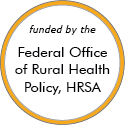Rural Project Examples: Behavioral health
Other Project Examples
One Health Recovery Doulas

Updated/reviewed November 2025
- Need: To support pregnant and parenting women with a history of substance use, mental health, or co-occurring disorders in rural areas of Montana.
- Intervention: One Health, a consortium of Federally Qualified Health Centers (FQHCs), developed a team of "recovery doulas" – individuals who are dual-certified as doulas and peer-support specialists. The One Health recovery doula program offers group and individual services to women and their partners from pregnancy through the first years of parenthood.
- Results: A team of four recovery doulas (or doulas-in-training) employed by One Health offer services in 8 rural eastern Montana counties. One Health has also successfully trained and certified 35 Peer Recovery Doulas statewide through their Peer Recovery Doula certification curriculum.
The Coffee Break Project
Updated/reviewed November 2025
- Need: Men in the agriculture industry face high suicide rates due to factors including long hours, geographic isolation, lack of social opportunities, and stigma surrounding mental health care.
- Intervention: The Coffee Break Project, a program led by Valley-Wide Health Systems, Inc. in southeastern Colorado, encourages mental health check-ins for farmers and ranchers through a public awareness campaign and casual coffee gatherings that utilize COMET, an intervention model developed specifically for rural communities.
- Results: Between eight and 20 people typically attend each coffee gathering.
FirstLink Care and Support Program
Updated/reviewed July 2025
- Need: To reduce suicide and substance-related deaths in North Dakota and Minnesota.
- Intervention: The Care and Support program provides support through phone calls, cards, and texting to those who have called suicide helplines or were referred by a healthcare provider.
- Results: In 2024, FirstLink sent 2,870 cards and texts to program participants and made 12,378 total contacts.
Together With Veterans Rural Suicide Prevention Program
Updated/reviewed July 2025
- Need: Suicide among veterans has been steadily increasing, and rural veterans have an increased risk of death by suicide compared to urban veterans.
- Intervention: A program called Together with Veterans was formed to help rural communities address and prevent suicides among veterans. The initiative is veteran-led, collaborative, evidence-based, and community-centered.
- Results: Data collection is ongoing.
Hope Squad
Updated/reviewed June 2025
- Need: To reduce youth suicide rates.
- Intervention: First begun in Utah, Hope Squad is a nationwide program that trains youth to identify peers' signs of distress and connect them to help. Hope Squads educate the entire student body to increase connectedness and reduce stigma.
- Results: Studies suggest that Hope Squad schools' students with suicidal thoughts are more likely than non-Hope Squad schools' students to solicit help. In addition, stigma surrounding mental illness is decreasing.
The Sapling Center
Updated/reviewed June 2025
- Need: To create a safe space for youth and young adults, ages 14 to 25, in rural eastern Kentucky.
- Intervention: The Sapling Center provides independent living skills education and offers a wide array of services as well as fun activities in a supportive environment.
- Results: The 5 Sapling Center locations serve 50-75 teens and young adults every day.
Together We Can Be Bully Free
Updated/reviewed June 2025
- Need: Union Parish, a rural county in Louisiana, continues to experience elevated rates of youth suicide, bullying, mental health challenges, and risk behaviors, as confirmed by a 2024 Community Health Needs Assessment (CHNA).
- Intervention: Union General Hospital, a Critical Access Hospital, started a program to educate students grade 4 through 12 on the negative effects of bullying, to foster positive social behavior, and to provide mental health support through school-based interventions.
- Results: Over 3,500 students have learned how to recognize, report, and respond to bullying. The program's integration with broader community health priorities has strengthened mental health, reduced suicide attempts, and improved awareness of youth risk behaviors.
Positively Living & Choice Health Network
Updated/reviewed May 2025
- Need: To provide affirming, destigmatized healthcare and support to thousands of Tennesseans living with HIV/AIDS, mental illness, substance use disorder, and homelessness – and prevention services for individuals at risk of contracting HIV.
- Intervention: Positively Living & Choice Health Network provides services including a medical clinic, pharmacy, therapy, case management, client services like housing aid and transportation, HIV prevention, and a harm reduction program.
- Results: The program currently serves 5,000 individuals and families through its offices in Knoxville, Chattanooga, Memphis, and Cookeville and its mobile medical unit for rural communities in Cocke and Claiborne counties.
Project ACTIVATE (Advancing Coordinated and Timely InterVentions, Awareness, Training, and Education)
Updated/reviewed May 2025
- Need: To improve students' access to behavioral health services in rural North Carolina.
- Intervention: North Carolina Project ACTIVATE provides three tiers of behavioral health supports in the school setting.
- Results: The six pilot sites (Cohorts 1 and 2) have created or revised 91 mental health policies, and 48,531 school-based and related employees have received training in different topics and protocols.
Recovery Kentucky
Updated/reviewed April 2025
- Need: To provide housing and recovery services for rural Kentuckians dealing with substance use.
- Intervention: Recovery Kentucky has 8 rural locations and provides apartments within a congregate living environment and an opportunity to begin recovery from substance use disorder in a structured, peer-led 12-step environment.
- Results: The rural and urban centers serve up to 2,200 people annually. An independent university-led resident outcome evaluation showed significant improvements in clients' drug and alcohol use, housing and employment status, decrease in criminal justice improvement, and improved health and mental health.
For examples from other sources, see:
